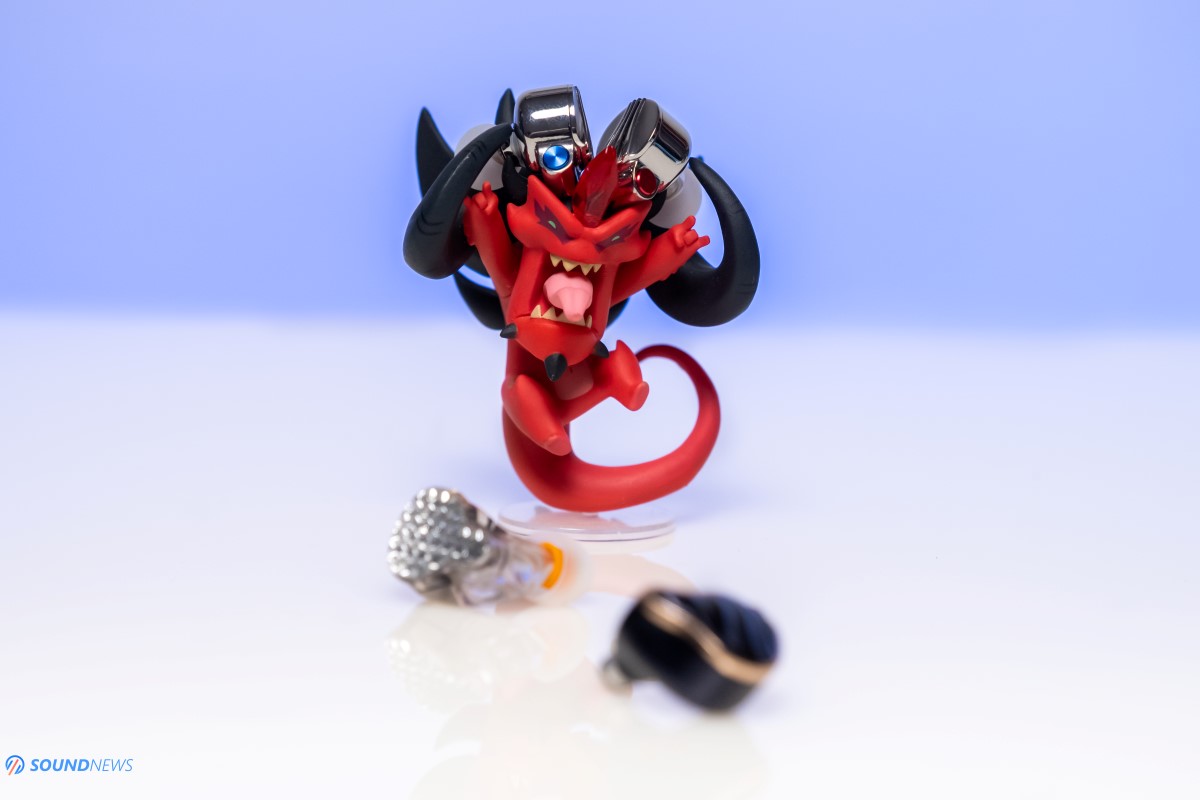FiiO FD5 IEM Review – Soundstage King
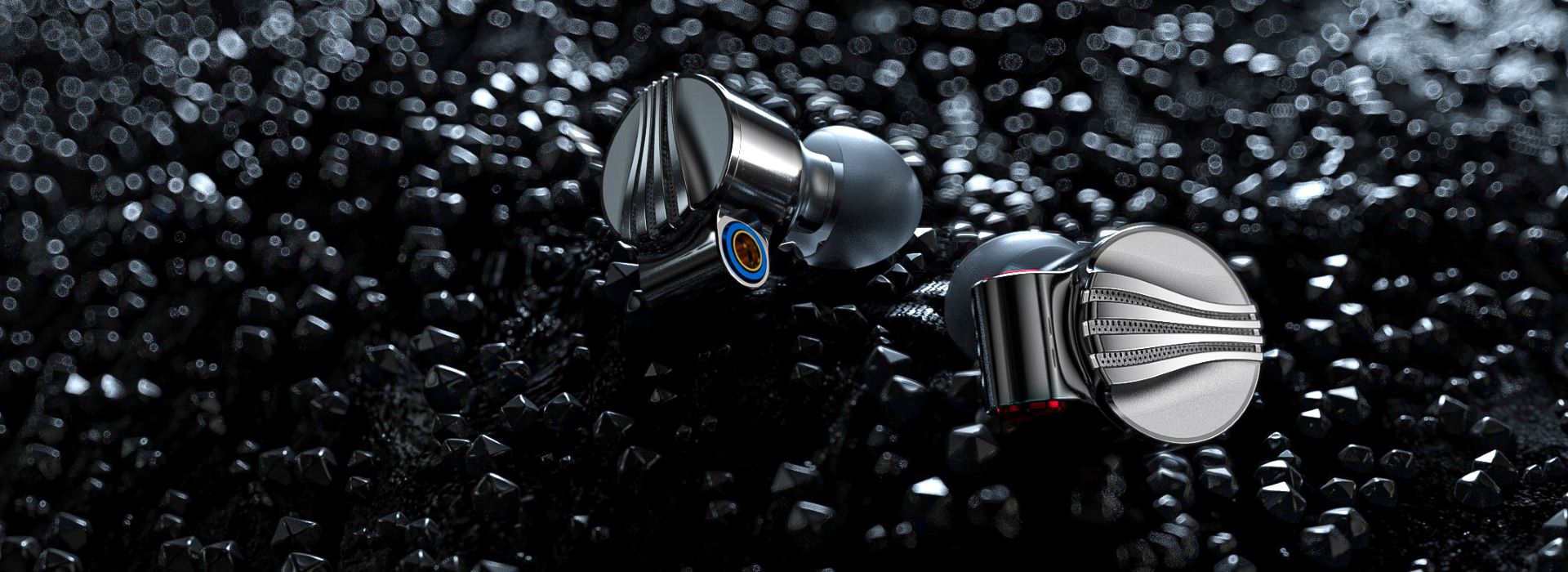
My Video Review:
When FiiO came out of nowhere a decade ago, they came with affordable portable headphone amplifiers to be used with iPods. Since then, slowly but surely FiiO crawled in every corner of portable audio. So much so, that nowadays there isn’t a product type that FiiO isn’t already making. They also tested grounds of desktop audio with K5 and K5 Pro, but soon they’ll make a much bigger splash with their upcoming K9 and K9 Pro all-in-one units which I cannot wait to put my hands on.
When it comes to portable audio, they went deep into the rabbit hole, starting with small Bluetooth dongles, to portable DAC and headphone amplifiers, to high-performance DAPs and finishing with IEMs split into 4 categories: Hybrid IEMs (FH line-up), all armature IEMs (FA line-up), Earbuds (EM line-up) and recently a new line-up was revealed, their dynamic driver only FD line. FD1 that was released a few months ago felt more like a proof of concept, but FD5 that I will testing today is something else entirely. Starting with packaging, bundled accessories, build-quality and finishing with sound performance, FD5 is on another level altogether, as it’s their flagship single driver dynamic IEM. FD5 is priced at $320 and let’s find out together if they are worth it or not.

Unboxing Experience
FD5 are currently their best dynamic IEMs and as with all higher-end gear, FiiO prepared an outstanding unboxing experience that is reminding of their FA9 and FH7 packaging. Double boxed isn’t a luxury anymore, but a norm in the Hi-Fi business, exactly as it should. The smallest matte-black box is quite thick, surrounded by two layers of foam as extra protection measures. On the left you’ll be greeted with the IEMs themselves and on the right with a beautiful thick leather-case. This is by far the best leather case FiiO came up with, it has removable dividers and its surrounded by a super soft velvet. In case you’ll want another one, FiiO is selling it separately, check for FiiO HB5 on their AliExpress store or ask your nearest FiiO reseller for one.
Lifting the first layer of foam, another floor is being revealed, home to the rest of the accessories. On the right there is a smaller box that houses a cleaning brush, a pair of interchangeable sound tubes, a yellow MMCX clip that will help you remove the cable much easier and two interchangeable headphone jacks: a 2.5mm balanced and a 4.4mm balanced one. FiiO did really kill three birds with one stone, as the included cable has 3 interchangeable audio jacks and that is probably the best idea they came up with.
On the left you’ll find a bigger ear tip collection split into 5 categories, as follows
- Balanced ear tips (3 pairs of S, M and L – the standard white silicone ones). These don’t sound bad at all, but these aren’t offering a proper seal for me, so bass is less thumping and less present in my tunes. I would never use these.
- Vocal ear tips (3 pairs of S, M and L – the white silicone ones with red inner tubes). These are boosting the midrange presence, pushing all those voices closer to the listener.
- Bass ear tips (3 pairs of S, M and L – the grey silicone ones with a red inner tube). Self-explanatory, are you a bass-head? These will rock your world.
- Tri-Flange ear tips (2 pairs of S and L – the longest white silicone ones) Etymotic users know them very well. They should be inserted deeper for a better seal. Sadly, they don’t work for me, my ear-holes are not that large (Yet!) Insert at your own risk
- Memory foam tips (2 pairs in M size only – the black foam sticky ones). These are my favorite ear tips, I find them most comfortable, they leak considerably less compared to others, resulting in a better bass delivery.
An impressive packaging no doubt, but even more impressive was seeing the number of accessories laying inside. FD5 is covering all my needs, including 4.4mm and 2.5mm balanced connections.
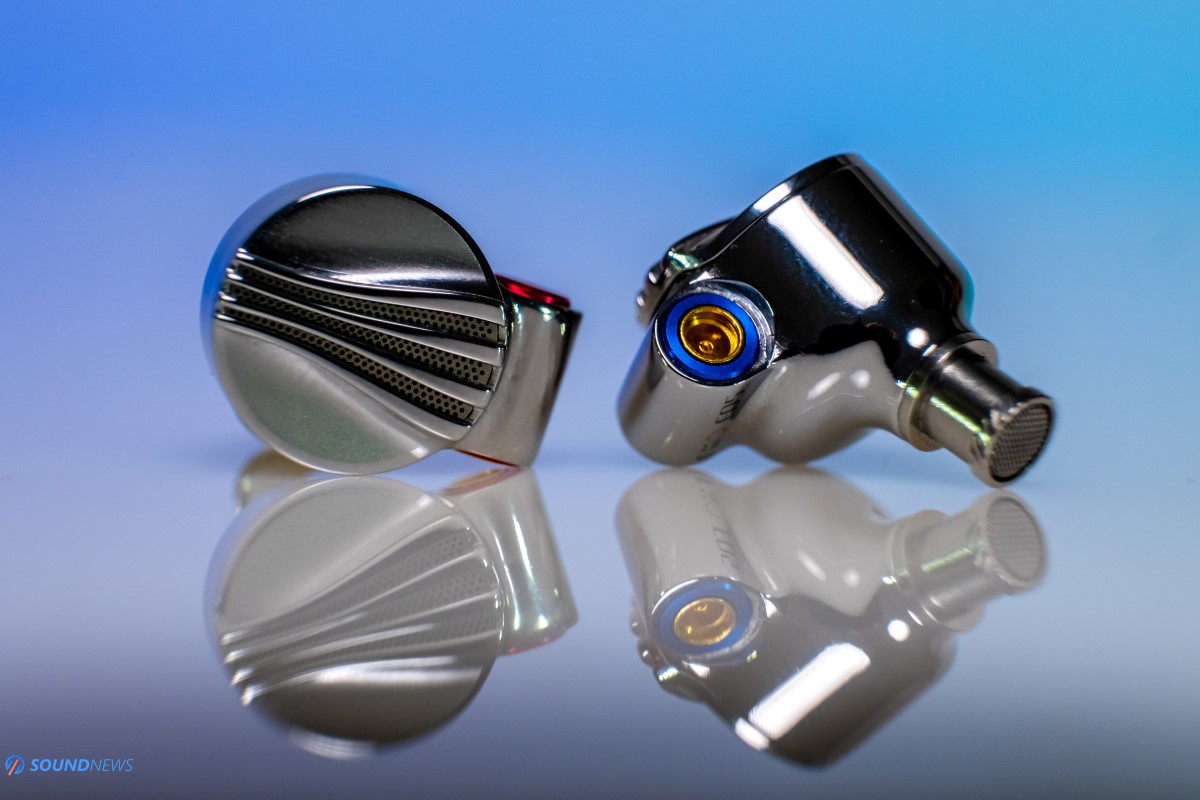
Design & Build Quality
Looks is always a very subjective thing, but in my opinion, these are one of the best-looking IEMs FiiO released of late. Its shell is made out of polished stainless steel, it’s a little heavier than any other IEM FiiO released so far. It is 3 times heavier than FD1 and 2 times heavier than FA7, but I really like the added weight as it gives some confidence and an impression of a high-quality product. I have another hobby collecting EDC (Every Day Carry) flashlights, small and heavy ones are always the rarest and the coolest ones to collect and somehow FD5 is reminding me about them.
FD5 are looking flawless to me, they even laser engraved its model number which looks pretty cool. FD5 is a semi-open design and if you would closely inspect the outer cover, you can spot some tiny holes in it, so that the air excess behind the driver would move outside, lowering the distortion and increasing the perception of air in your music. The IEM shell does also have a small hole in it, that will remove the air pressure between your ear canal and the IEM body, for a much better comfort long term. The stock nozzle has a length and a diameter of 5mm, so you can easily use your growing ear tip collection, not only those found in the package. I personally tested several Spin-Fit and Comply foam tips and they all worked nicely together.
Cable Quality
FD5 is using a detachable cable, it’s very flexible, it doesn’t have any microphonics and seems to be really well made. Considering that FiiO is offering three interchangeable headphone jacks for it covering all your needs, I really don’t see the point of buying separately a better headphone cable.
The cable uses 152 high-purity silver-plated copper wires, 8 strands with a thickness of 24 AWG and the cable itself is 18 AWB – quite thick actually.
It uses MMCX connectors and in all seriousness, I never experienced a stronger MMCX bond with a headphone, its rock solid with FD5 and with my bare hands I cannot detach the cable. It is a whole lot stronger compared to FH7 and FA9 and if you are playing with third party cables on a regular basis, you should carry the yellow plastic thingy with you at all times, it’s a huge problem solver.
Exchanging the headphone jack with another one is super easy, just unscrew the metal shell, pull by the male end and it’s out. Insert your desired jack back aligning the 4-pins, screw back the metal shell and it’s done.
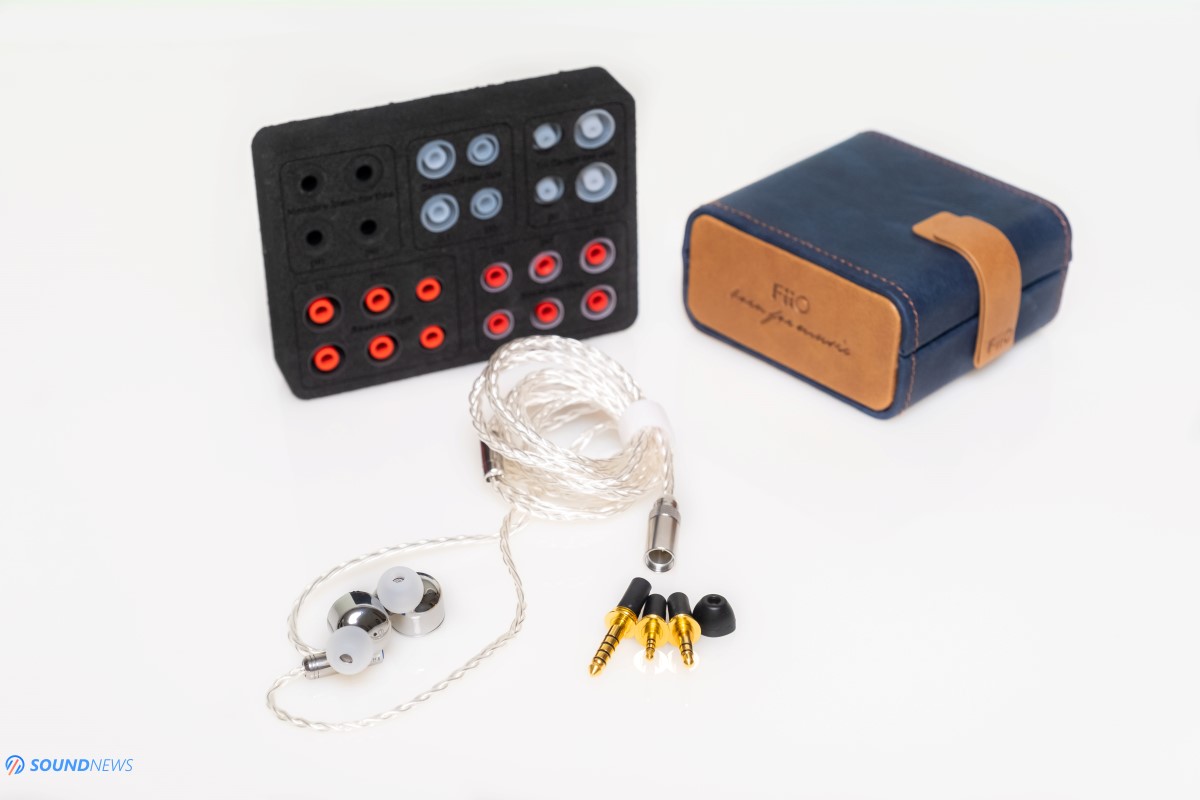
Tech Inside FD5
FD5 is having a single Beryllium-coated dynamic driver per IEM. Yes, just one, but it’s a big one. With a diameter of 12 mm, helped by powerful N52 Neodymium magnets, FD5 achieved a staggering magnetic flux of 1.5 Tesla for a speedy bass delivery and clear undistorted treble. The same magnetic flux can be also found in top-of-the-line desktop headphones as Audeze LCD-4, LCD-MX4, Fostex TH900 MKII and TH909.
It was important designing a lightweight but extremely rigid diaphragm, so a super thin layer of Beryllium was applied on its driver surface. Beryllium is widely used in the high-end audio, FiiO uses it in their high-end IEMs, Focal is using it in their high-end headphones and loudspeakers. Paradigm, Yamaha, Magico and TAD are all high-end loudspeaker manufacturers that are coating their drivers with Beryllium, since it’s super-light and extremely rigid.
Having a single driver in there, means that a passive crossover was completely bypassed, fully preserving the signal in its purest form possible. FD5 has an impedance of 32 Ohms and a sensitivity of 109 dB per 1mW of power, suggesting that these are quite easy to drive. Most portable audio sources shouldn’t have issues driving them at very loud levels, I’ll test that soon and report back.
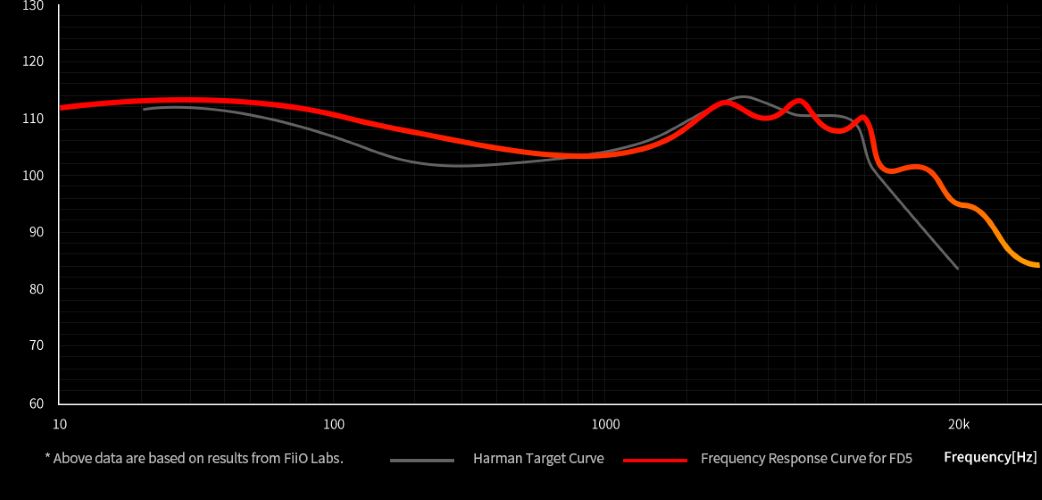
What is quite interesting is that FiiO used the IE 2017 Harman Curve as a reference, tuning their FD5 as close to it as possible, here is a picture FiiO posted on their website. I will be measuring them in the latest chapters of this review, so make sure to read until the end for a detailed measurement analysis.

Sound Performance
I. Preliminary Sound Impressions
The absolute first impressions were how clean, undistorted and easy going these sounded. There was a feeling of smoothness and liquidity that cannot be found on hybrid or all-armature IEMs. The same feelings I had with their EM5 earbuds, that also had an amazing flow, binding all the notes together creating music instead of an amalgam of sounds. After listening to multi-driver IEMs for a few months and then switching to FD5, the immediate feeling is that every sound is coming precisely at the same time, from the same spot in a natural and undistorted way. Bass felt quite airy and ethereal, but also heavy weight and muscular, the soundstage was impressively well-spread, with a perfect positioning of every notes around me. There was plenty of air around those notes, the sound (weirdly enough) wasn’t exactly inside my head, creating a nice 3D image around me. It wasn’t a completely wide-open sound experience as I am normally hearing with open-back desktop headphones, but FD5 definitely sounded very much like the semi-open Ollo S4X and HarmonicDyne Zeus when it comes to depth information and scale.
Another thing that struck me is how close they sounded to the IE 2017 Harman Curve, as the bass was clearly boosted by a few dB, especially the mid-bass felt quite powerful and all over my music, then the treble felt sparkly, a little sharp, biting from time to time in the most sensitive part of our hearing, then the upper treble had less presence, rolling-off slowly and smoothly, creating a fiery top end but without some excessive brightness. Midrange wasn’t the best part of this headphone and while it starts strong and there is plenty of naturalness and warmth, it starts its descent, creating an impression of a hollow upper-midrange. FD5 is indeed the pure definition of a V-shaped sound done right. While there are ups and downs in the frequency response, those didn’t feel overdone, there is still a natural balance. There is no other way in saying that FD5 was tuned towards a fun listening experience, instead of a serious monitoring type of sound.
I’m burning them in for about 4 days now with desktop and portable power and every time I pick them up, unwillingly I’ll start slowly shaking my head to the rhythm of the music, FD5 is not a headphone that wants to disappear from your music, it almost screams for your attention when a bass or treble note is hitting your eardrum. Another thing that stood out immediately was the decay of the notes, it wasn’t pushed and it wasn’t slow, it was…natural, exactly as you are hearing in your everyday life. The sounds faded exactly at the right time, they weren’t disappearing as fast as they did on FiiO FA9 and to some degree on FH7. Bass notes lingered just for a microsecond longer, which did wonders with jazz and acoustic music, where speed is not the most important thing.
The thump in the ear-drums was clear and precise, it wasn’t that impactful as it was on FiiO FH7, but it’s plenty of it to impress a transient response nut as myself. Apart from the upper midrange that felt hollow and less sweet, everything else performed at a pretty high level.

II. Power Requirements
With a sensitivity of 109 dB per 1mW of power, these are not the most sensitive IEMs from my collection and are not the easiest to drive. They actually need a little bit more power compared to some desktop headphones like Kennerton Gjallarhorn which is very unusual but understandable, given a much smaller driver would need more juice to offer the same sound pressure level compared to a bigger driver. With all that said, these are still small and portable IEMs, so don’t worry that much about their power requirements, as even common audio sources as a laptop or a smartphone can drive these to really loud levels. Thanks Odin, my smartphone still has a headphone jack, presumably a Hi-Fi DAC inside too (which I seriously doubt) and at about 80% volume wise it was already too loud for me. With a Microsoft Surface Pro 7 there is even more headroom on tap, as at 65 to 70% it was pumping a lot of power mixed with some brain damaging noise-floor. These are not power hungry, but will definitely need as much power as a multi-driver IEM to shine bright. Both FiiO FA9 and FH7 needed a bit less power to achieve the same SPL and the same can be said about Kennerton Magni and Gjallarhorn headphones. Power wise, FD5 are pretty much on the same level with a pair of FiiO EM5, Sennheiser Momentum 2 and Meze 99 Classics, if you ever tested any of these.
I’ve tried them with portable DAPs and they sounded great out of them, I am personally against overly warm or smooth sounding ones, so I am recommending a faster and a punchier sounding source. From FiiO offerings, BTR5, Q3, Q5S TC, M11 PRO and M15 would work extremely well and a regular M11 and M5, not that much. Feed them a faster source and you’ll awake nicer dynamics in these, on the other hand feed them a mellower and a slower paced source like Shanling Q1 and FD5 can become too smooth and relaxed sounding to a point of being dull and boring sounding.
I also tried them out of several desktop headphone amplifiers and they sounded pretty much the same as they did on the go. Obviously, when a higher quality DAC will the powering a clean sounding desktop amplifier, the difference would be bigger. FD5 scaled nicely on a good source and I really like that these are not uber-sensitive to source and amplification noise, like FiiO FA9 are for example. The fastest, and the most enjoyable sound was still experienced out of a Benchmark HPA4, SMSL SP400, SH-9, Topping A50S and A90.

III. Transient Response
While indeed FD5 has a longer natural decay compared to multi-driver hybrids, but especially to all-armature IEMs, I had a total blast with them listening to several electronica albums. I just finished Random Access Memories (Tidal / Spotify) and I was simply hooked to its fuller and well-defined bass performance. It was more of it than usual, it had a longer decay too, but it was also clean, visceral and very layered and that worked exceptionally well with music like this. All types of rock and metal sounded impressively alive and @ss kicking. While these are not pressing the gas pedal and are never on a hurry when it comes to speed, these are really good when it comes to landing punches at the right moments. Slam is great and I didn’t expect less out of a 1.5 Tesla magnet, no matter what music would be on my playlist, the bass always carried more air, it had more weight to it, more heft and that translated into an extremely fun and engaging sound signature. Speed of delivery is not the best trait of FD5, but slam and impact surely are.
Some local folk tunes mixed with some red wine and rock music sounded juicy and scary real. Its semi-open design made all that easier to swallow as every single note wasn’t fighting for prime time. Muddiness never happened with these, FD5 are not up-front and closed-in sounding at all, on the contrary they were pushing the sounds farther away from me, so I never experienced clutter even with less than perfect tunes as rock and all its sub-genres.
Decay is fading naturally, it’s neither too short, nor too long, just right. With modern electronica, I sometimes wanted a higher sound pressure and a higher speed and acceleration, but with acoustic music, I didn’t have much to complain about. Indie rock albums like The Strokes – The New Abnormal (Tidal / Spotify) was mastered with a lot of mid-bass and treble presence that fits as a glove with IEMs like FD5. Its somewhat V-shaped sound emphasized the best parts of this album, overshadowing its drawbacks. I toe-tapped and I had a great time with these, as like an armature driver slipped inside, I couldn’t ask for a nicer slam and impact from them. Out of all FiiO IEMs, FD5 were more impactful to me than FA7 and FA9, but slightly less to FH7 which was understandable.

IV. Soundstage & Depth
FD5 is a semi-open IEM and it also moves more air down low, across the bass region and that translated into a bigger sound than usual. This is where FD5 is winning lost grounds compared to hybrid IEMs. When it comes to stage size, I am putting EM5 as numero uno from FiiO portfolio, followed by FD5 and then by the rest of their flagships like FA9, FA7 and FH7. Yes, my friends, FD5 is bigger and wider sounding than its pricier siblings and everything sounds around me as opposed to inside my head.
My body is releasing a lot more dopamine with great mastered classical with FD5 as opposed to other FiiO IEMs. Most IEMs can sound decently spacious, putting the musical notes in small air bubbles, but only few of them can remind you about open desktop headphones. Deutsche Grammophon is pretty much the best, or one of the best classical music label, they recently released Echoes by Signum Saxophone Quartet (Tidal / Spotify). Please give it a try! Even if you are not into classical. With this album I swore I was listening to a high-end open-back desktop headphone. It sounded grand, it was huge, the notes were flying in all directions, I was surrounded by them, there was an eerie feeling of silence between all those notes, there was a lot of air and a lot of tiny micro-details that felt so crisp and so real. Is this a binaural recording? Nope, it’s an old-fashioned stereo record that sounds like a proper 3D binaural recording. When I moved to regular IEMs, it wasn’t as grand and open, as if the windows towards music were half shut, or half opened if you are an optimist. I strongly believe that the scale of FD5 is one of its best traits and if you are a classical, acoustic music or jazz lover, you cannot go wrong with them.
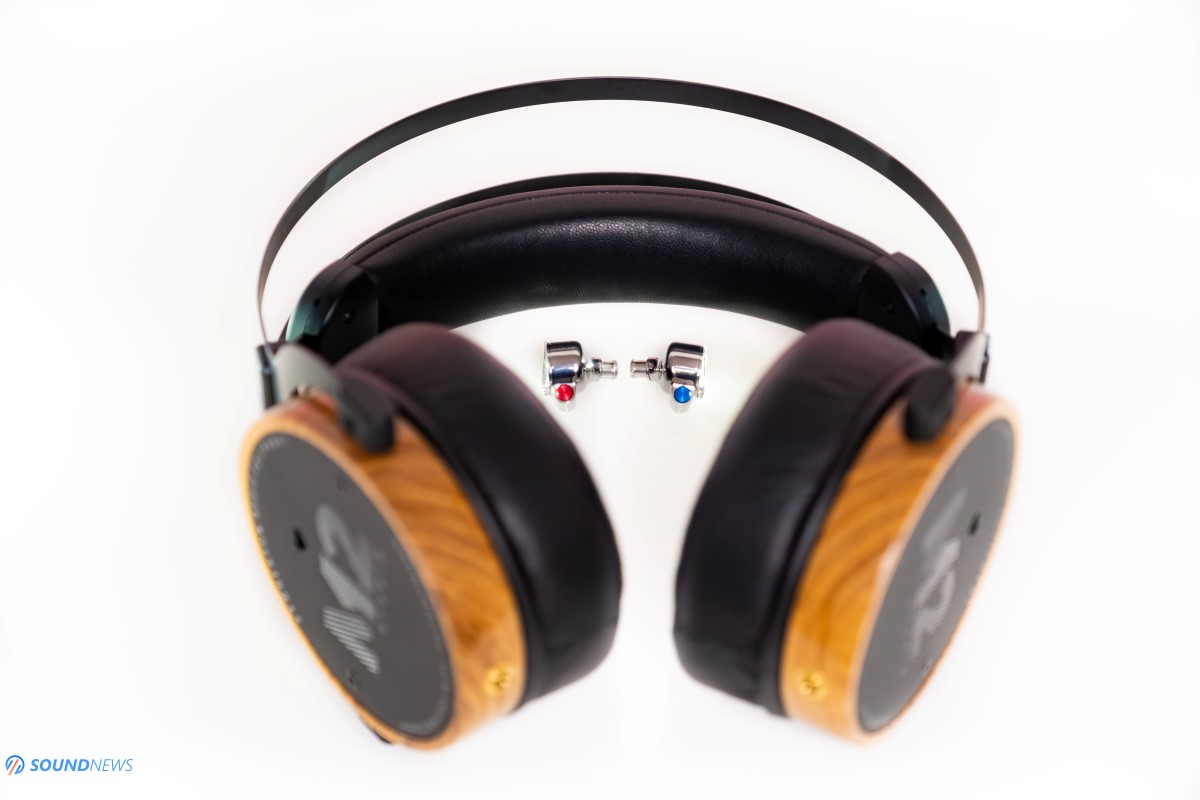
V. Detail Retrieval & Transparency
FiiO used a very capable Beryllium over carbon driver and it shows when you start playing highest quality recordings like the one I’ve mentioned in the previous chapter. I went ahead and tried over-driving them at 95 dB and then at 100 dB, I’ve listened only to a minute and then to several seconds with a 100 dB signal. This might sound weird to you, but the most detailed and lowest distortion headphones never had issues while being over-driven, clipping never occurred with such headphones and I was curious if FD5 would do the same. I was a little bit shocked as FD5 had a much lower distortion compared to FD1, FH1S, FH3, hell even to FH7 and FA9! I’m comfortable saying that FD5 has one of the lowest distortions I have experienced with IEMs, they are holding together even at much higher volumes, without having the notorious driver fart of the low to mid-fi IEMs. FD5 are clean sounding, very detailed and will easily show to you the slightest nuances and the tiniest micro-details from your music. I was taken away by the capability of this driver, so I went and ran a full set of measurements that will be revealed very soon.
So far, I didn’t measure a better performing dynamic driver in an IEM body. There isn’t a super long trail in the bass, bass notes are not overlapping with midrange and the rest of the FR always felt precise, defined and clear sounding. To some degree I find them even more detailed compared to multi-driver IEMs. There is always a raw and unpolished feeling with some particular Chi-Fi IEMs, but there is nothing of that in here, not even a footprint. FD5 are smooth, quite gentle with the right music, very polished and controlled even at much higher levels.
A huge helping hand gives the most sensitive part of our hearing, somewhere between 4 and 6 kHz felt extra defined, it’s a bit elevated on FD5 and that gives an impression of a higher transparency, of sharper notes, of more air around those notes. FiiO went with a clever tuning, since the Harman curve is targeting a fun musical experience with a slight treble boost and that paid off big time.

VI. Frequency Response
FiiO’s flagship dynamic driver IEMs can be summarized as having a perfect bass performance, linear in the midrange with a slight roll-off at the end of it, it super impressive in the low to mid-treble region and then it sees a slow and gentle roll-off that will help in long listening sessions.
A. Bass
Sub-bass is very impressive even from 20 Hz, I didn’t run 20 Hz sweep tones as those were very present in my tunes and quite obvious from the start. The bass performance of FD5 is simply spectacular, it is linear, it is fast, it hits hard, there aren’t traces of distortion and it always felt clean. It is a breathing type of bass and if there are layers and layers of it, you’ll easily hear that with FD5. There is nothing bad I can say about its bass performance, because it simply reminds me about high-performance planar bass. The hardest test there is was passed with flying colors.
Mid-bass feels pretty much the same, it is slightly elevated and it makes its appearance the most in my tunes, it is by a hair higher in intensity compared to all other sounds (except for mid-treble). Thanks to its powerful mid-bass delivery I was experiencing that thump and slam in the eardrums, it hit like a hammer on several occasions and that was always pleasing to experience.
B. Midrange
Midrange felt like a double-edged sword. On one side, the lower and the mid-section up to ~900 Hz felt defined, in line with what I would describe as linear sounding. Jazz and Classical still had that mid-section vibe, emotions would still run through my veins with such music, it was almost a soul-grabbing experience, but not quite there yet. Piano went down and decayed naturally, violins had a longer vibration, but weren’t as real and believable sounding to me. On the other side, the upper midrange sees a slope and a roll-off that intensifies the hollow effect. It can be solved with a mild 2 to 4 dB increase in the 1 to 2.5 kHz region. Human voices are happening exactly in this region and sometimes I wanted to boost their presence so I could be carried away by their singing.
C. Treble
It is pretty cool experiencing cymbals and bells in a very clear and defined way, there is more bite in there and more sharpness. Sometimes it goes a little overboard, but only a little and in very short bursts. Forget about the nasty KZ brightness or about the raw Chi-Fi treble, that is not the case in here. The only bad thing I can say about its treble, is that its intensity was higher than usual. However, I can’t find excessive ringing with them, there is no distortion, there is no bloat or a lack of refinement, nothing of that in here. Treble is boosted in the most sensitive part of our hearing; some might like that and some might not. For me, that is a fresh new sound, as my other IEMs are not performing like this.
Overall, FiiO achieved everything they wanted to, it follows precisely the Harman curve, there are lots of good things to say about FD5 and very little to nitpick.

VII. Measurements
Okay everyone, let run a full set of measurements and see how they perform. When it comes to measurements, my best friend is still the Benchmark HPA4 as it is as linear as headphone amplifiers could go and I used both the Matrix Element X and the Audiobyte HydraVox as the main DACs for the job. The measurement rig was the MiniDSP E.A.R.S. calibrated with IDF (IEM Diffuse Field) compensation files. Do note that MiniDSP E.A.R.S. is not following any IEC standards, meaning that my readings can’t be used as reference measurements. I’m doing them just to get a general idea about their sound signature.
I’ve measured them only by using the memory foam ear-tips and the silicone ear tips, some other ear-tips would not offer a perfect seal, completely destroying the bass performance in the process. I’ve measured them more than 15 times, as finding a perfect fit and a complete seal was quite a challenge.
![]()
This is their RAW FR measurement and as you can see, their driver matching is phenomenal, there is only a very small deviation somewhere around 17 to 18 kHz which isn’t that important. I have re-inserted them several times in the test rig and I’ve got exactly the same set of measurements with the silicone and memory-foam tips.
![]()
Applying a 1/12 smoothing not a lot of things are changing. You can clearly see its impressive bass performance even starting with 20 Hz. It is super impressive in here; almost unbelievable how clean and linear it is. As you can see, it’s extended down low and goes as a straight line until upper midrange is reached, where a slope and gentle roll-off can be observed. Treble is uneven and elevated by several dB in multiple key areas. The most sensitive part is elevated by ~7 dB and there is another rise at ~13 kHz after which it starts its descent. FD5 definitely follows the Harman Curve as much as possible

Their Total Harmonic Distortion (THD) reading is something that I never experienced with IEMs yet, it sits at 0.22% and that is very impressive. Audeze LCD-4, Kennerton Wodan and Meze Empyrean have all a much higher THD, only Hifiman Susvara recorded a lower THD. Impressive is not the right word in here. The flagship FiiO FA9 had a much higher THD, more exactly 0.63% – it’s still low, but not uber-low as it is on FD5.

Its spectral decay is great too, look at that barely visible blue mass. You want it to be as low as possible and again FD5 outperformed its siblings in here too. It has a lightning-fast recovery of the driver and that translates into a very low Total Harmonic Distortion (THD), which I just mentioned before.

Spectrogram is super clean and is not showing weird driver behavior, as it would happen with multi-driver IEMs. You can also see the hot zones better; the treble is sometimes sharp and too present in some particular tunes.
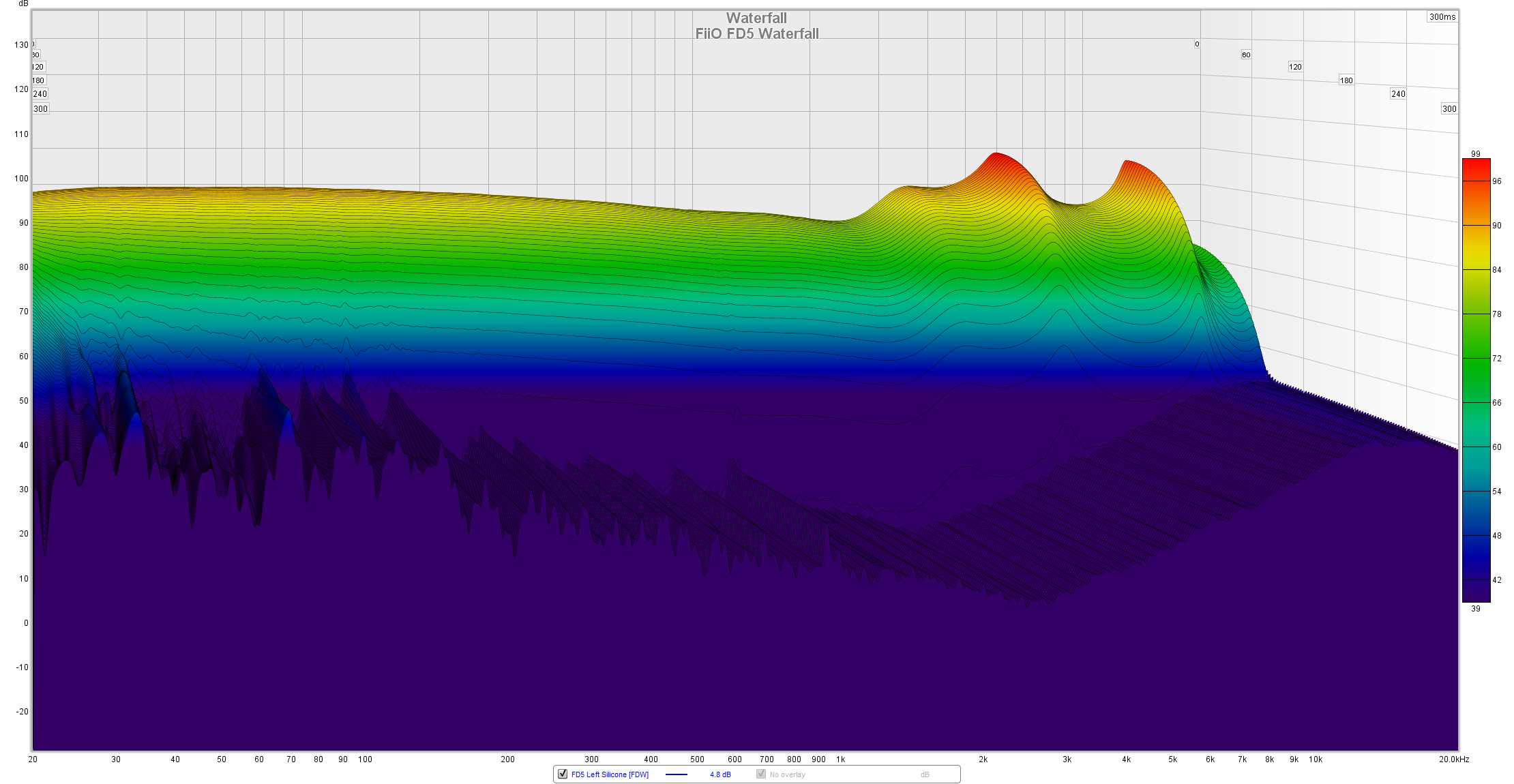
Now look at that beautiful smooth waterfall, it is very good in here, much better than what I’ve anticipated. If that hot treble is bothering to you, it can be tamed with a parametric EQ, or with a simple one from your software music player.
![]()
If you are curious how silicone tips would sound compared to memory-foam ones, here’s a graph that will tell you more. They look pretty much the same on this graph with mirror differences in the treble, but in real life that depends on the anatomy of your ear canal. I have a better seal with memory foam tips, that are further increasing the bass delivery for me.

Conclusion
In some ways FD5 awoke some distant memories when I was listening to the single driver Sennheiser IE800 for the first time. Nobody believed single driver IEMs could sound as good as top-of-the-line multi-driver IEMs would, until Sennheiser proved everybody’s wrong some 9 years ago. FD5 stomped over many pricier IEMs by offering higher levels of detail, a lower distortion and a speedier diaphragm recovery. Its soundstaging capabilities are also up there with the nicest IEMs I’ve experienced thus far. It’s V-shaped tuning strictly follows the Harman curve that might not be to everybody’s liking. I find it unique and fresh sounding, with an engaging sound signature attached. Any headphone jack would sound good with them, but if you want to squeeze the best out of them, check their BTR5 or M11 PRO which would perform flawless. It is my pleasure to recommend the FD5 as a great sounding and great measuring IEM at quite an affordable price.
About that, FiiO FD5 will cost you $320, you can get them directly from FiiO’s AliExpress Store, you can try your local distributor or you can get them from HiFiGo which is shipping them worldwide. I am not affiliated with either of them, so get them from your favorite store.
PROS:
- Cool unboxing experience
- A nice selection of accessories
- Nicely crafted, amazing finish
- Comfortable long term
- One of the widest soundstage I’ve experienced with IEMs
- Good pin-point location of all the notes
- High levels of detail retrieval, great transparency
- Clean, powerful, undistorted bass performance
- Some of the nicest measurements I’ve recorded so far
- Natural decay, smooth sounding
- Easy to drive
CONS:
- Treble can be problematic sometimes, it is elevated by several dB
- Hollow upper-midrange is taking away some magic
- Some might want a speedier presentation
ASSOCIATED EQUIPMENT:
- Sources: Xiaomi Mi 9T Pro, Corsair One i160
- DACs: Audiobyte HydraVox + HydraZap, Matrix Audio Element X, Flux Lab Acoustics FCN-10, Burson Conductor 3X Performance
- DAPs: Shanling M6, FiiO M15
- Headphone Amps: Benchmark HPA4, SparkoS Labs Aries, Flux Lab Acoustics FCN-10, LittleDot MKIII SE, SMSL SP400, Topping A50S
- Power Amps: KECES S300
- IEMs: FiiO FD5, FA9, FH7, FH3, Meze Rai Penta, Rai Solo, LittleDot Cu KIS & lots of other lower tiered ones
- Portable headphones: Sennheiser Momentum 2, Meze 99 Classics
- Full-sized headphones: Hifiman Susvara, Hifiman Arya, Audeze LCD-4, Erzetich Phobos, Erzetich Mania, Kennerton Wodan, Magni, Gjallarhorn, Vali, M12S, Quad ERA-1, Ollo S4X Reference
- Loudspeakers: KEF Reference 3
- Interconnects: QED Reference (x3), Topping TCX1 (x2)
- Speaker cables: Kimber PR8, Audioquest Type4
- Power Cables: Isotek EVO3 Premier (x3)
- Balanced Isolation Power Conditioners: PLiXiR Elite BAC400
